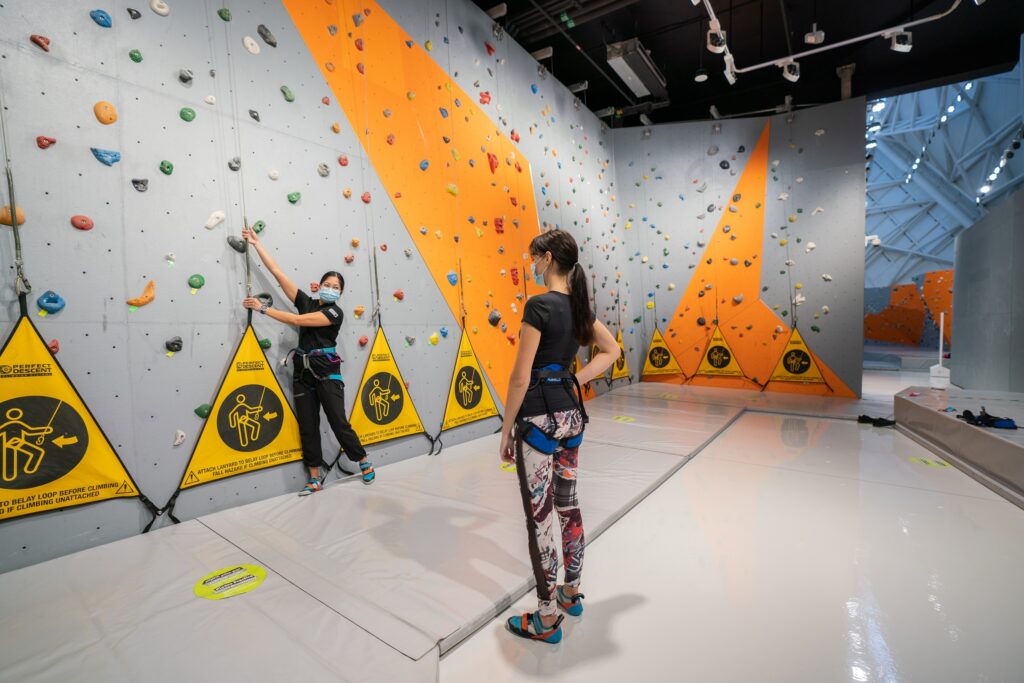Even the most experienced climbers would agree that finessing the fundamentals is the only way to safely enjoy indoor climbing.

Welcome to indoor climbing; a world of movement, pure technique, strength and endless fun. Just like any sport, indoor climbing requires regular practice and there are risks involved. Although there are many schools of thought and best techniques for first timers, even the most experienced climbers would agree that finessing the fundamentals is the only way to safely enjoy indoor climbing.
Over at CLYMB™ Abu Dhabi, the UAE’s ultimate adventure hub, guests can learn about indoor climbing with the supervision of the facility’s certified instructors using their safety harness, shoes and some climbing chalk. Here are our top five tips to get you started:
Tip #1: Warm up
Before engaging in any movement, the body needs to be warmed up to prevent any injury and to maximize its potential. Mobility and a deep stretch will get the blood flowing to the muscles and increase the heart rate which will enable more oxygen to reach the body and in turn improve the overall athletic performance. A good warm-up will require muscle contraction and relaxation to help the body work faster, smoother and more efficiently. Indoor climbing also demands mental preparation to create a healthy workflow between technique, coordination and skills, which are all key components to a safe and enjoyable training session.
Tip #2: Technique is key
When learning how to climb, most beginners will likely feel weak and sore, especially in the forearms. This is normal because just like any sport, our muscles will be exerting effort and energy to apply different techniques before we can adapt to a new physical activity.
Begin by practicing your footwork and body positioning. Decide in what order you want to start and put it into action. Look after your footwork and properly position your feet as it will support your lower body to propel you towards the wall. Your legs are so much stronger than you think!
Tip #3: Practice your balance
Balance is crucial, if not the most important pillar of climbing. To maintain a well-balanced center of movement while climbing, start with core exercises and movements to strengthen your muscles to reduce the risk of injury. A useful tip to keep in mind is that the stronger the core, the more efficient and powerful the body becomes, which will improve the overall balance. A pivotal factor for success here is not to solely rely on the biceps; an effective technique is to try to push up the wall through the legs, while keeping the arms straight and the hips as close to the wall as possible to maintain energy levels without feeling depleted.

Tip #4: Stay calm
Breathe, breathe and breathe! Climbing is a sport that requires energy and puts a great deal of tension on the muscles; reason being why controlling the breathing will impact our physical and mental health to reach its peak performance. Breathing is an art and even the most skilled athletes tend to overlook this important yet basic action. When you hold your breath, the natural exchange of oxygen and carbon dioxide does not occur, which hinders the body’s ability to excel in the execution of the movement. As such, practicing the right breathing technique will help you stay calm, improve your concentration and increase muscle strength. Equally important is having a good footwork technique as our legs are a major muscle group which engages the lower body to maintain proper composure and can significantly improve the breathing cycle while climbing.
Tip#5: Safety is important
It is highly recommended to wear clothes that are comfortable enough and suitable for climbing to ease the overall movement, such as sports leggings or yoga pants. Listening to the instructors’ directions during briefing is as important to help amateurs get the most out of their first climbing experience. Make sure to wear the safety equipment as instructed using a harness and climbing shoes. Indoor climbing also requires climbers to drink water before, during and after the session. In fact, staying hydrated will increase energy levels, improve the movement and boost recovery and agility.
With many tips to keep in mind, indoor climbing can be overwhelming for beginners. Starting with the basics and mastering the foundations of this sport will help scale each level to suit every climber’s preference. Did you know guests at CLYMB™ Abu Dhabi can take on five walls of varying heights and difficulty, including the region’s tallest wall, The SUMMYT?
For more information, please visit: https://www.clymbabudhabi.com/






